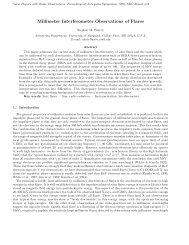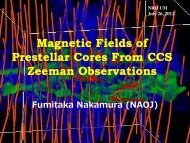Physics of the Solar Active Regions from Radio Observations
Physics of the Solar Active Regions from Radio Observations
Physics of the Solar Active Regions from Radio Observations
Create successful ePaper yourself
Turn your PDF publications into a flip-book with our unique Google optimized e-Paper software.
46 G. GelfreikhFig. 4.. <strong>Radio</strong> maps <strong>of</strong> an active region on <strong>the</strong> sun at <strong>the</strong> wavelength <strong>of</strong> λ =1.76 cm on June 09 (left) and June 14 (right), 1995 obtainedwith Nobeyama radioheliograph. On <strong>the</strong> right picture shows <strong>the</strong> active region (coronal loop) over <strong>the</strong> limb. I-maps are shown at <strong>the</strong>top, V-maps — in <strong>the</strong> middle. Below <strong>the</strong>y are overlaid.Fig. 5.. <strong>Radio</strong> scans <strong>of</strong> <strong>the</strong> sun (I & V ) at <strong>the</strong> wavelength <strong>of</strong> λ =4.32 cm on June 16, 1999 obtained with radio telescope RATAN-600.Below <strong>the</strong> spectra <strong>of</strong> <strong>the</strong> main sources in total intensity and polarization are shown. The strength <strong>of</strong> <strong>the</strong> maximum coronal field forevery polarized source is shown above or below its scan.Fig. 6.. The distribution <strong>of</strong> magnetic field above a sunspot with height for sunspot group No.142 (bulletin ”Solnechnye Dannye”).Optical and radio observations were made on June 28, 1993.














